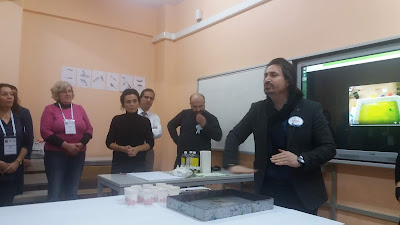The Journey Through Time
We consider
this experience wonderful as we not only visited historical monuments but
also made friends for the rest of our lives.
One of the
monuments that we visited was Palazzo Vecchio (Old Palace) that became the seat of government at that time. It later became the symbol of the
Florentine Republic in 1300. It remained the center of power also during the
Medici command. We quite liked it.
The Pitti
Palace (Palazzo Pitti) a large Renaissance palace of Florence.
Its appearance is currently of the 17th century, originally in 1458. Created by
Lucas Fancelli, which was later bought by the Medici Family to serve as the
official residence.
Duomo also known as
Florence Cathedral; its construction begun at the end of the thirteenth
century, Project of Arnolfo di Cambio. One of the greatest Gothic masterpieces
and the beginning of the Italian Renaissance and which was also finished in
1434. It is the main historical building of the city.
Unfortunately,
we did not have time to visit because of the long queues and the lack of time.
Ponte
Vecchio - famous Ponte Vecchio is a mediaval arch bridge over the Arno River,
also famous for having a number of shops (mainly goldsmiths and jewelers). It
was said that it was built in ancient Rome and was made of wood at the
beginning.
The Chapel
of the Medici (Cappelle medicee, in Italian) is inside the Basilica of St.
Lawrence. It was built by the Medici Family during the Renaissance and
currently reaches two buildings: the Sacristy Nova (designed by Michelangelo)
and the Capella dei Principi (Chapel of the Princes). It is considered one of
the most important religious buildings in Tuscany.
Villa Medicee di
Poggio a Caiano, also called Ambra or Capriccio del Magnifico, is one of the
most famous Villas of the Medici Family, and is located in the municipality of
Poggio Caiano. The gardens that surround the village are of great interest,
especially of the nineteenth century. The Villa Medicee di Poggio a Caiano is
the first example of Renaissance architecture that fuses the lessons of the
classics (in particular Vitruvius).

Giardin di Boboli,
its history began in 1418 when the Medici Family purchased the Pitti Palace. This
will be built forty years earlier than the Palazzo Pitti. The Boboli Gardens
have many green areas, known as the Garden of the Cavaliere (Giardino del
Cavaliere in Italian) produced partly on one of the walls designed by
Michelangelo in 1529.Casino del Cavaleire was a playground of the Grand Dukes
of Tuscany, now owns the Porcelain Museum (Museo delle Porcellane). The garden
was designed by Niccolò Pericoli, with contributions of Giorgio Vasari and
Bernardo Buontalenti, his works began between the 16th and 18th centuries, it
was opened to the public in 1766.
We found the
gardens interesting, large and beautiful despite small inconveniences.
This was a unique opportunity of our lives and we
think we have made the most of it. We will never forget these moments.
TRABALHO REALIZADO POR: MADALENA MONTEIRO E MATILDE CARDOSO




















































